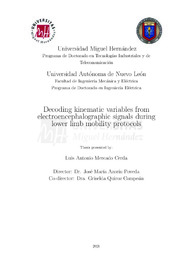Por favor, use este identificador para citar o enlazar este ítem:
https://hdl.handle.net/11000/27498Registro completo de metadatos
| Campo DC | Valor | Lengua/Idioma |
|---|---|---|
| dc.contributor.advisor | Azorín Poveda, José María | - |
| dc.contributor.advisor | Quiroz Compeán, Griselda | - |
| dc.contributor.author | Mercado Cerda, Luis Antonio | - |
| dc.contributor.other | Departamentos de la UMH::Ingeniería de Sistemas y Automática | es_ES |
| dc.date.accessioned | 2022-07-12T11:37:32Z | - |
| dc.date.available | 2022-07-12T11:37:32Z | - |
| dc.date.created | 2021-09-21 | - |
| dc.identifier.uri | https://hdl.handle.net/11000/27498 | - |
| dc.description.abstract | Due to the prevalence of disabilities that affect the lower limbs in the growing population, it seems necessary to provide assistance to those that lost their ability to walk and grant means to those that lack such function. A brain-computer interface (BCI) is a useful technology that includes systems or devices that sense and respond to neural processes, allowing a disabled user to interact with any device by interpreting neurophysiological signals. BCI systems have been based on electroencephalography (EEG) which consists of sensing electrical signals from the brain using noninvasive sensors on the surface of the scalp. BCIs appear to be under two categories: the discrete classification of human tasks and the continuous trajectory reconstruction of kinematics or kinetics. This research consists on proving that it is possible to make a continuous trajectory reconstruction, also called decodification, from slow cortical potentials, i.e., low frequencies of the EEG signals. In this study, two types of lower limb mobility protocols are proposed: synchronous movements consisting in raising and lowering the foot or the knee within fixed time periods, and asynchronous movements consisting of self-paced continuous flexions and extensions of the knee in a given set of time. The first approach presents evidence of the nonlinear characteristics of the EEG signals during synchronous lower limb mobility protocols. Whereas in the literature, it has only been reported the characterization of these signals between different mental states. To characterize the behavior of the EEG signal, the randomness, complexity, nonstationarity, and nonlinearity of the EEG were studied. Firstly, randomness is analyzed by the Hurst exponent, which also is used to characterize the nonstationary behavior of the EEG signals. In this thesis, the Hurst exponent values of the brain signal show a nonrandom persistent time series, when considering small time windows. The correlation dimension is used as a measure of the complexity of the system related to the number of degrees of freedom, and it is also used to distinguish between random, periodic, or chaotic behavior. The correlation dimension has shown that the underlying system of the brain can range in a relatively low number of dimensions. Finally, the largest Lyapunov exponent is used to confirm the presence of chaos in the underlying dynamics of the time series. In this thesis, the largest Lyapunov exponent values seem to be strictly positive, which is often considered as a definition of deterministic chaos. Implying that the underlying dynamics is indeed nonlinear. With these insights, we could define a nonarbitrary selection of a candidate model (e.g., computational model or neural network) to classify motion tasks and/or to resolve the continuous trajectory reconstruction of lower limb kinematics. This selection could provide reliable and affined methods for EEG-based BCI systems to manipulate assistive devices useful in neuromuscular rehabilitation. The second approach presents additional evidence of decodification using slow cortical potentials. Different electrode arrays and time ranges were tested to compare performances of the reconstruction, proving certain electrodes contribute in greater amount than others to the decodification. The decodification of segmented signals for different types of tasks gave a better performance compared to using a single decoder for the entire signals. Finally, the usage of transformation functions to the EEG signals in order to later be used by the decoder proved there exists combinations of equations that give better results than using the EEG signal directly. In summary, the approach to characterize the EEG signals gives information that can be useful for further studies regarding the mathematical modeling of neural activity during motor tasks. Whereas the second approach shows evidence of improvement for decodification of the kinematics from neural signals. Both results could be starting points to further improve the understanding of neuro-motor tasks and their application of artificial reproduction of movements from EEG signals through a BCI. | es_ES |
| dc.format | application/pdf | es_ES |
| dc.format.extent | 174 | es_ES |
| dc.language.iso | eng | es_ES |
| dc.publisher | Universidad Miguel Hernández de Elche | es_ES |
| dc.rights | info:eu-repo/semantics/openAccess | es_ES |
| dc.rights.uri | http://creativecommons.org/licenses/by-nc-nd/4.0/ | * |
| dc.subject | Cibernética | es_ES |
| dc.subject | Teoría de sistemas | es_ES |
| dc.subject.other | CDU::6 - Ciencias aplicadas::62 - Ingeniería. Tecnología | es_ES |
| dc.title | Decoding kinematic variables from electroencephalographic signals during lower limb mobility protocols | es_ES |
| dc.type | info:eu-repo/semantics/doctoralThesis | es_ES |

Ver/Abrir:
Mercado Cerda, Luis Antonio_compressed.pdf
4,45 MB
Adobe PDF
Compartir:
 La licencia se describe como: Atribución-NonComercial-NoDerivada 4.0 Internacional.
La licencia se describe como: Atribución-NonComercial-NoDerivada 4.0 Internacional.
.png)